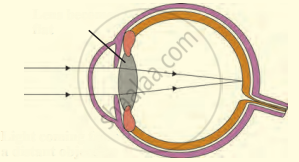Advertisements
Advertisements
Question
A person got his eyes tested. The optician's prescription for the spectacles reads:
Left eye: − 3.00 D
Right eye: − 3.50 D
The person is having a defect of vision called:
(a) presbyopia
(b) myopia
(c) astigmatism
(d) hypermetropia
Solution
myopia
The optician has prescribed concave lenses for the person's spectacles, as a concave lens decreases the converging power of the eye lens. This shows that the person is suffering from short-sightedness, or myopia.
APPEARS IN
RELATED QUESTIONS
A person got his eyes tested by an optician. The prescription for the spectacle lenses to be made reads :
Left eye : +2.50 D
Right eye : +2.00 D
State whether these lenses are thicker in the middle or at the edges.
The eyes of a person are focused (i) on a nearby object, and (ii) on a distant object, turn by turn. In which case:
the converging power of eye-lens will be the maximum?
What is meant by power of accommodation of the eye?
The following figure show the change in the shape of the lens while seeing distant and nearby objects. Complete the figures by correctly labelling the diagram.

Draw the struture of human eye and label its parts.
The muscular diaphragm that controls the size of the pupil is ____________.
Match the following:
| Column - I | Column - II |
| 1. Retina | a) Path way of light |
| 2. Pupil | b) Far point comes closer |
| 3. Ciliary muscles | c) near point moves away |
| 4. Myopia | d) Screen of the eye |
| 5. Hypermetropia | e) Power of accommodation |
Match the following:
| Column - I | Column - II |
| 1. Retina | a. Path way of light |
| 2. Pupil | b. Far point comes closer |
| 3. Ciliary muscles | c. near point moves away |
| 4. Myopia | d. Screen of the eye |
| 5. Hypermetropia | e. Power of accommodation |
An aperture that controls the passage of light into the eye is ______.
Name the following:
Two pigments of the sensory cells.
